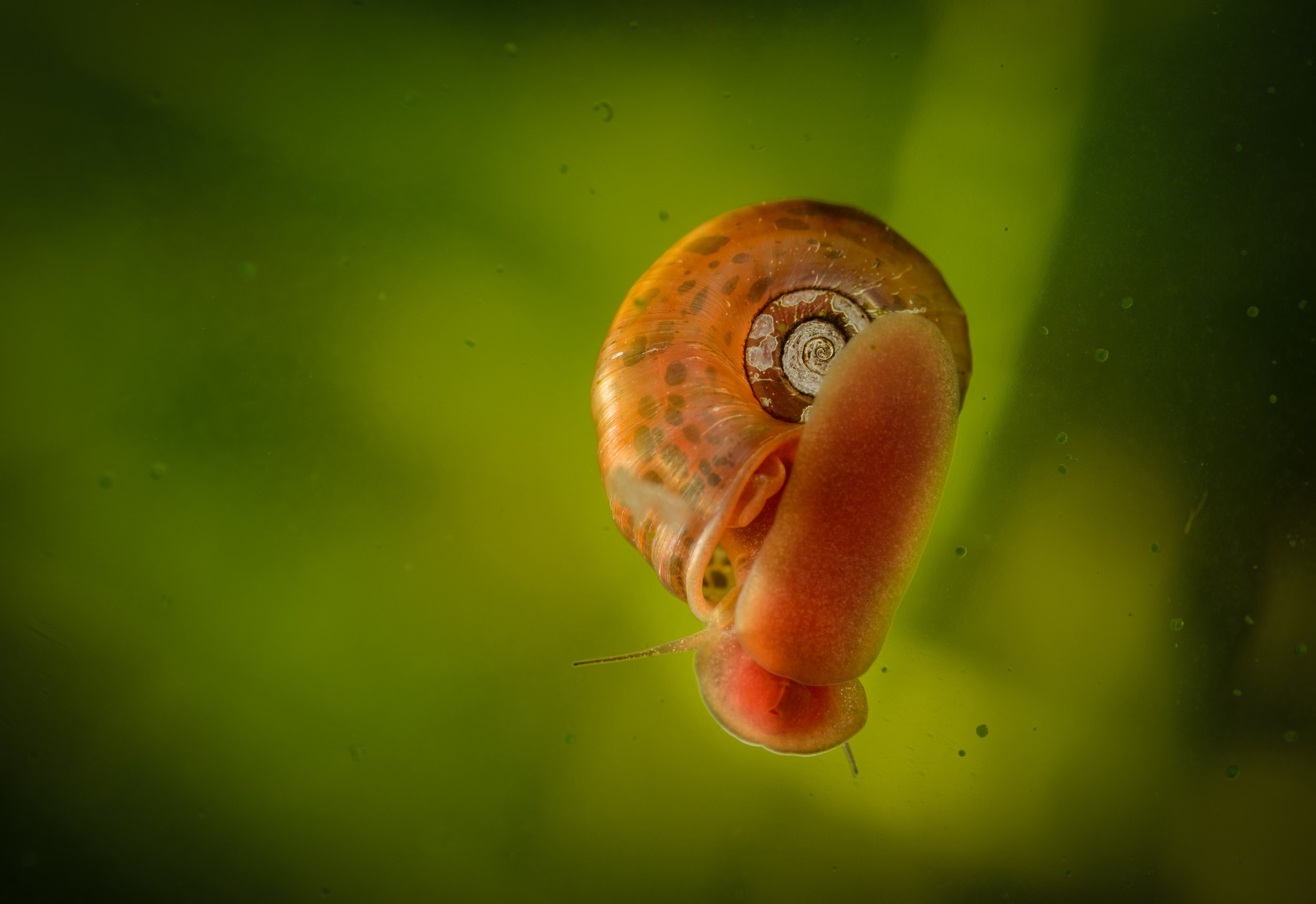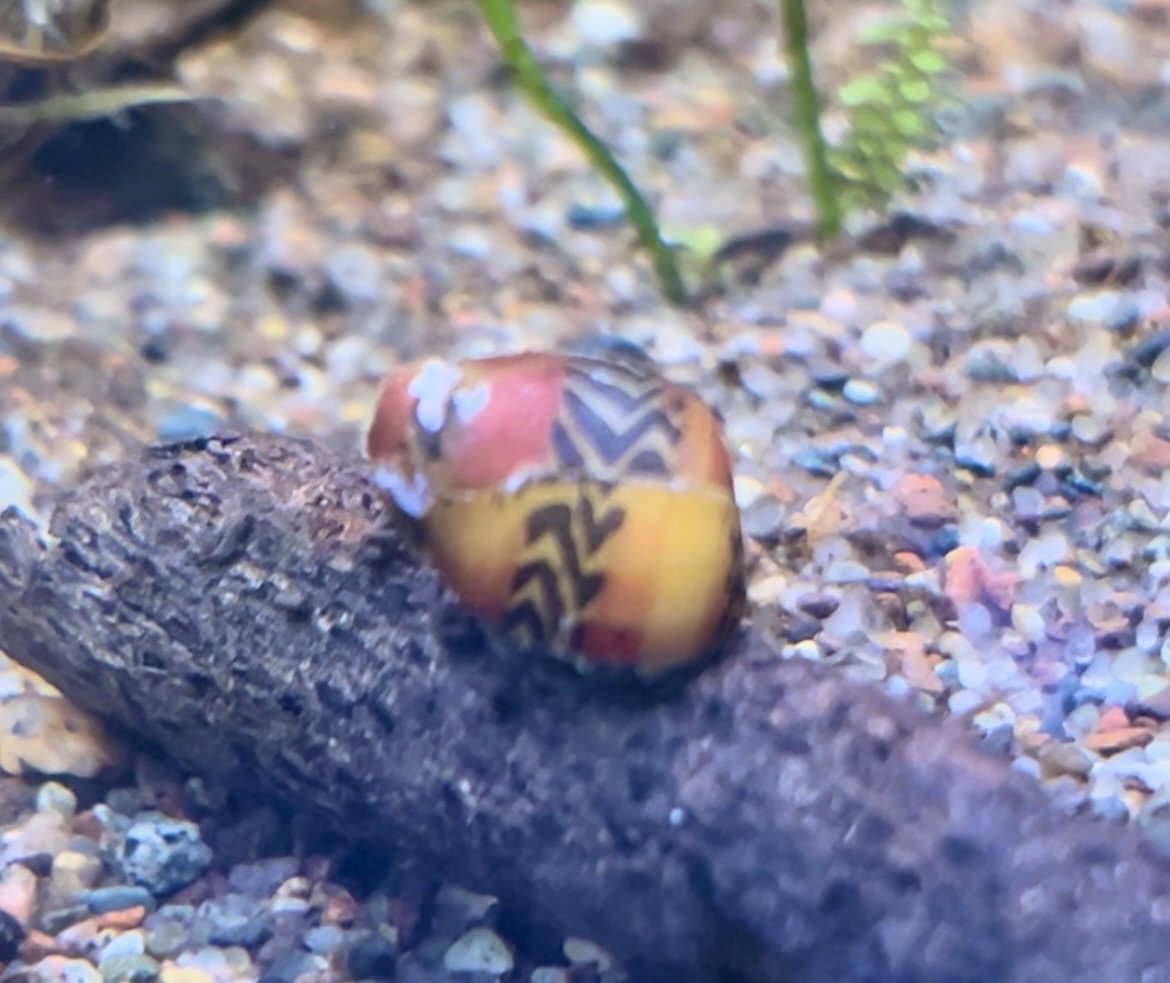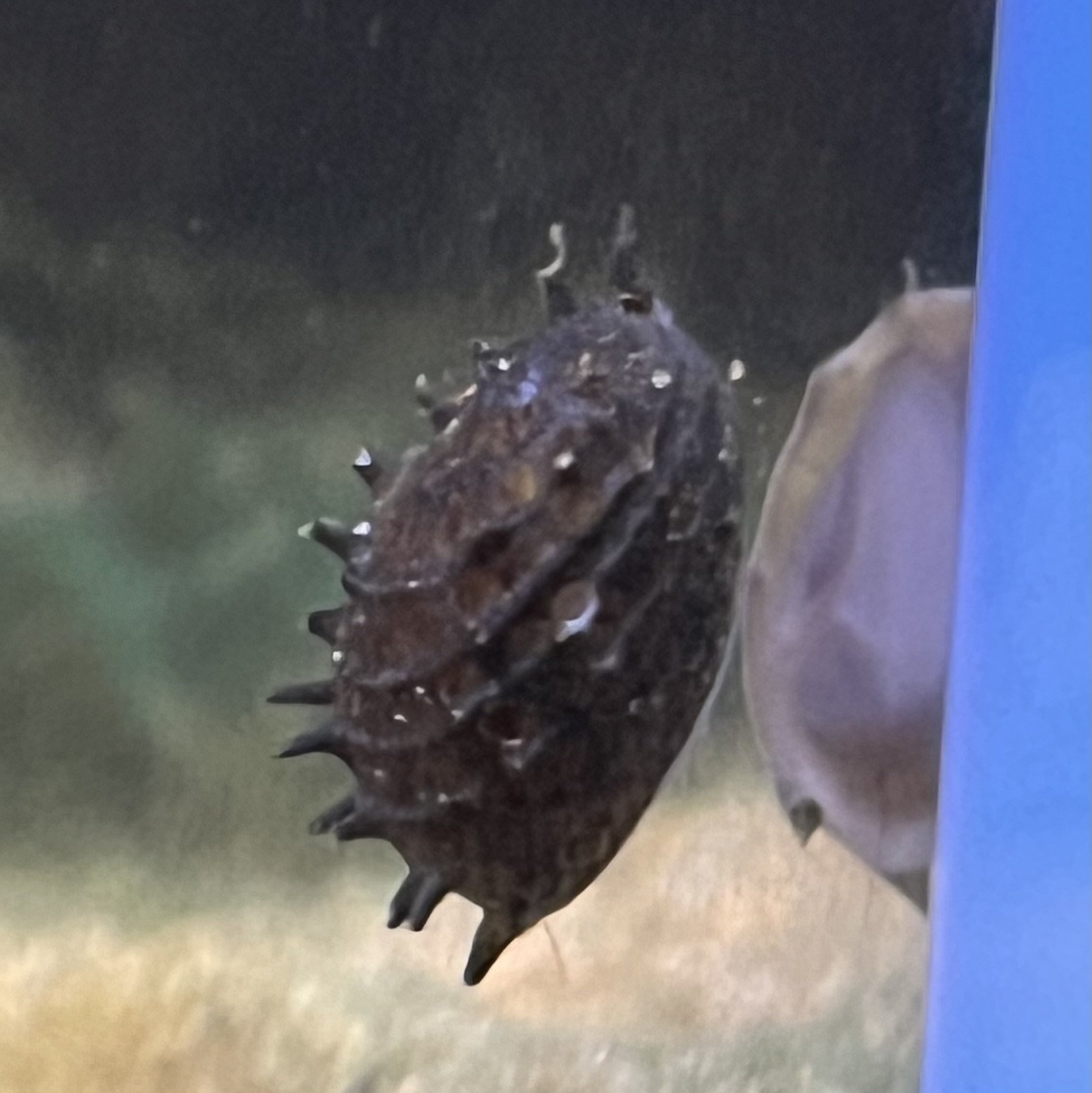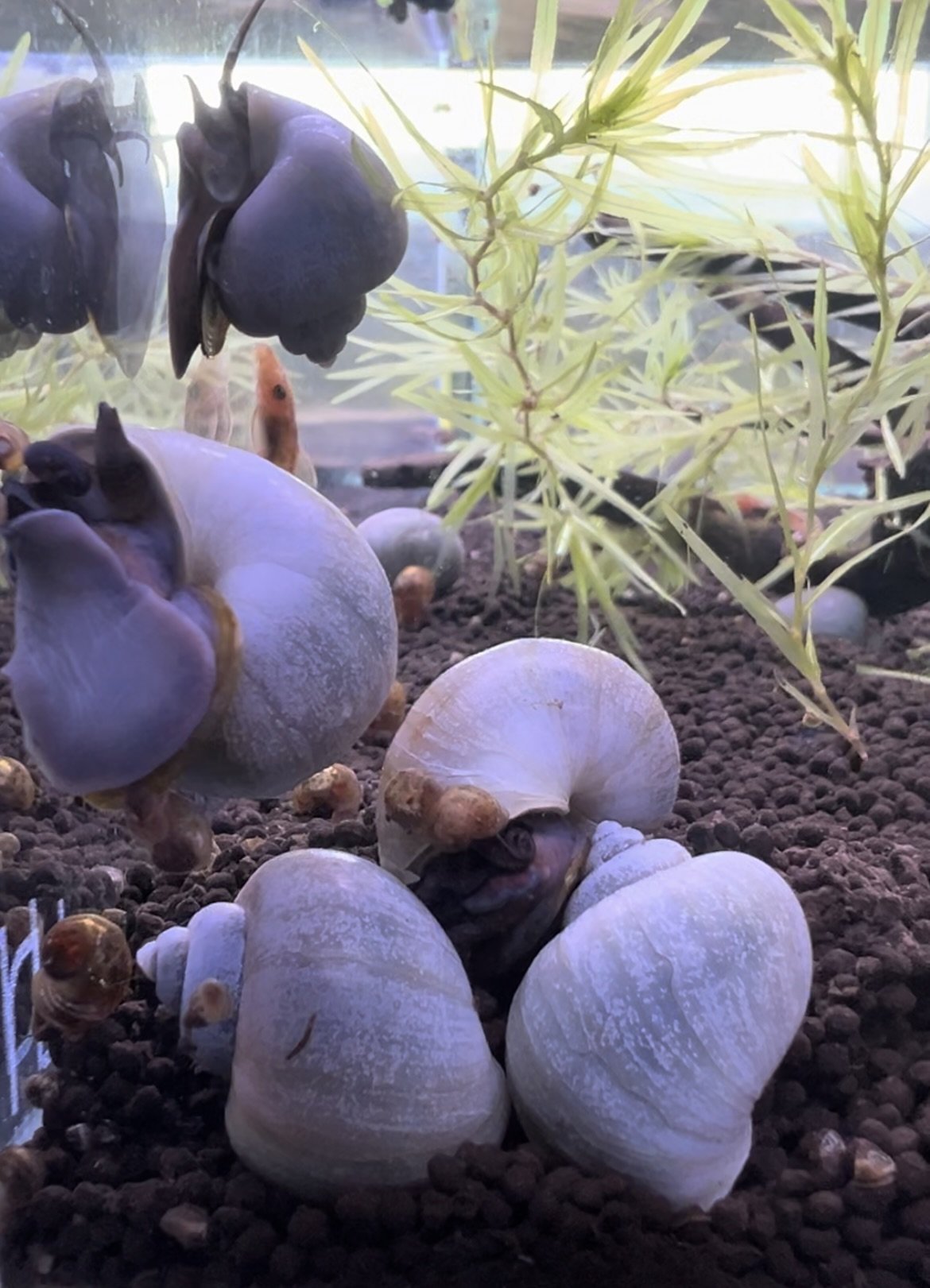 Image 1 of 3
Image 1 of 3

 Image 2 of 3
Image 2 of 3

 Image 3 of 3
Image 3 of 3




Red Ranshorn Snail
The Ramshorn Snail (Planorbella duryi) is a freshwater snail species known for its distinctive spiral-shaped shell and versatile nature in aquariums. Native to North America, including regions of the United States and Canada, the Ramshorn Snail is highly valued by aquarists for its efficient algae-cleaning abilities, peaceful demeanor, and ease of care, making it a popular choice for freshwater tanks of various sizes.
Physically, Ramshorn Snails exhibit a flattened, disc-shaped shell with a distinct spiral pattern, resembling the shape of a ram's horn or coil. The shell may vary in color, ranging from shades of brown, red, and black to translucent or spotted patterns, depending on factors such as diet, genetics, and environmental conditions. Mature specimens can reach sizes of up to 1 inch (2.5 centimeters) in diameter.
In aquariums, Ramshorn Snails are valued for their algae-eating abilities, diligently grazing on various types of algae, including green algae, diatoms, and soft algae films. They also consume leftover fish food, decaying plant matter, and detritus, helping to keep the aquarium clean and balanced. Ramshorn Snails are particularly effective in planted tanks, where they help to maintain healthy plant growth and water quality.
Ramshorn Snails are peaceful and solitary creatures that can be kept in small groups without aggression or territorial behavior. They are compatible with a wide range of tank mates, including fish, shrimp, and other snail species. However, care should be taken to avoid housing them with aggressive or predatory tank mates that may harm or harass them.
In terms of care, Ramshorn Snails are relatively low-maintenance and adapt well to a variety of water parameters. They prefer stable water conditions with temperatures between 68 to 78°F (20 to 25°C) and a pH range of 7.0 to 8.0. Providing ample hiding places and surfaces for them to explore, such as rocks, driftwood, and plants, enhances their well-being and natural behavior.
Breeding Ramshorn Snails is relatively straightforward, as they are prolific breeders capable of reproducing rapidly under favorable conditions. They lay clusters of gelatinous eggs on surfaces above the waterline, which hatch into miniature versions of the adults. Providing a secure lid or cover on the aquarium prevents the snails from escaping and helps protect the eggs from drying out.
Overall, the Ramshorn Snail is a versatile and beneficial addition to freshwater aquariums, prized for its unique appearance, algae-cleaning abilities, and peaceful nature. Whether kept as a solo specimen or in a small group, these fascinating snails add color, charm, and functionality to any aquatic environment, making them a beloved choice among aquarists of all experience levels.
The Ramshorn Snail (Planorbella duryi) is a freshwater snail species known for its distinctive spiral-shaped shell and versatile nature in aquariums. Native to North America, including regions of the United States and Canada, the Ramshorn Snail is highly valued by aquarists for its efficient algae-cleaning abilities, peaceful demeanor, and ease of care, making it a popular choice for freshwater tanks of various sizes.
Physically, Ramshorn Snails exhibit a flattened, disc-shaped shell with a distinct spiral pattern, resembling the shape of a ram's horn or coil. The shell may vary in color, ranging from shades of brown, red, and black to translucent or spotted patterns, depending on factors such as diet, genetics, and environmental conditions. Mature specimens can reach sizes of up to 1 inch (2.5 centimeters) in diameter.
In aquariums, Ramshorn Snails are valued for their algae-eating abilities, diligently grazing on various types of algae, including green algae, diatoms, and soft algae films. They also consume leftover fish food, decaying plant matter, and detritus, helping to keep the aquarium clean and balanced. Ramshorn Snails are particularly effective in planted tanks, where they help to maintain healthy plant growth and water quality.
Ramshorn Snails are peaceful and solitary creatures that can be kept in small groups without aggression or territorial behavior. They are compatible with a wide range of tank mates, including fish, shrimp, and other snail species. However, care should be taken to avoid housing them with aggressive or predatory tank mates that may harm or harass them.
In terms of care, Ramshorn Snails are relatively low-maintenance and adapt well to a variety of water parameters. They prefer stable water conditions with temperatures between 68 to 78°F (20 to 25°C) and a pH range of 7.0 to 8.0. Providing ample hiding places and surfaces for them to explore, such as rocks, driftwood, and plants, enhances their well-being and natural behavior.
Breeding Ramshorn Snails is relatively straightforward, as they are prolific breeders capable of reproducing rapidly under favorable conditions. They lay clusters of gelatinous eggs on surfaces above the waterline, which hatch into miniature versions of the adults. Providing a secure lid or cover on the aquarium prevents the snails from escaping and helps protect the eggs from drying out.
Overall, the Ramshorn Snail is a versatile and beneficial addition to freshwater aquariums, prized for its unique appearance, algae-cleaning abilities, and peaceful nature. Whether kept as a solo specimen or in a small group, these fascinating snails add color, charm, and functionality to any aquatic environment, making them a beloved choice among aquarists of all experience levels.
The Ramshorn Snail (Planorbella duryi) is a freshwater snail species known for its distinctive spiral-shaped shell and versatile nature in aquariums. Native to North America, including regions of the United States and Canada, the Ramshorn Snail is highly valued by aquarists for its efficient algae-cleaning abilities, peaceful demeanor, and ease of care, making it a popular choice for freshwater tanks of various sizes.
Physically, Ramshorn Snails exhibit a flattened, disc-shaped shell with a distinct spiral pattern, resembling the shape of a ram's horn or coil. The shell may vary in color, ranging from shades of brown, red, and black to translucent or spotted patterns, depending on factors such as diet, genetics, and environmental conditions. Mature specimens can reach sizes of up to 1 inch (2.5 centimeters) in diameter.
In aquariums, Ramshorn Snails are valued for their algae-eating abilities, diligently grazing on various types of algae, including green algae, diatoms, and soft algae films. They also consume leftover fish food, decaying plant matter, and detritus, helping to keep the aquarium clean and balanced. Ramshorn Snails are particularly effective in planted tanks, where they help to maintain healthy plant growth and water quality.
Ramshorn Snails are peaceful and solitary creatures that can be kept in small groups without aggression or territorial behavior. They are compatible with a wide range of tank mates, including fish, shrimp, and other snail species. However, care should be taken to avoid housing them with aggressive or predatory tank mates that may harm or harass them.
In terms of care, Ramshorn Snails are relatively low-maintenance and adapt well to a variety of water parameters. They prefer stable water conditions with temperatures between 68 to 78°F (20 to 25°C) and a pH range of 7.0 to 8.0. Providing ample hiding places and surfaces for them to explore, such as rocks, driftwood, and plants, enhances their well-being and natural behavior.
Breeding Ramshorn Snails is relatively straightforward, as they are prolific breeders capable of reproducing rapidly under favorable conditions. They lay clusters of gelatinous eggs on surfaces above the waterline, which hatch into miniature versions of the adults. Providing a secure lid or cover on the aquarium prevents the snails from escaping and helps protect the eggs from drying out.
Overall, the Ramshorn Snail is a versatile and beneficial addition to freshwater aquariums, prized for its unique appearance, algae-cleaning abilities, and peaceful nature. Whether kept as a solo specimen or in a small group, these fascinating snails add color, charm, and functionality to any aquatic environment, making them a beloved choice among aquarists of all experience levels.




